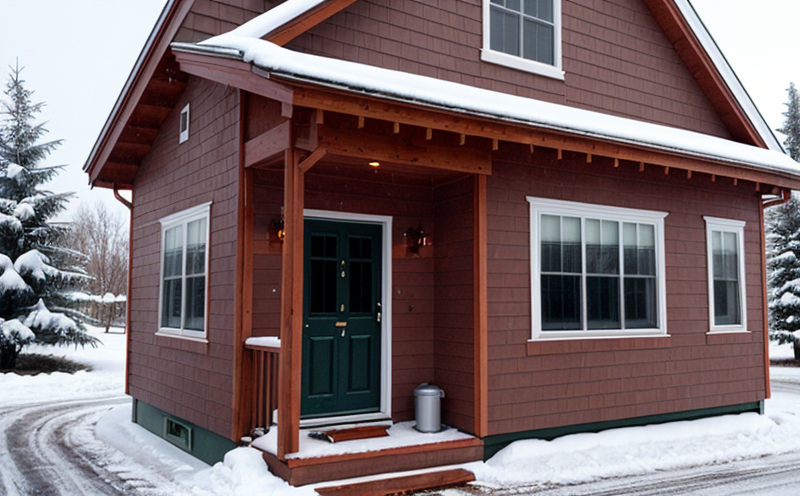DIN EN 14790 Seasonal Radiator Output Test
The DIN EN 14790:2008 standard provides a framework for testing the seasonal radiator output of water-to-air heat exchangers, commonly known as radiators. This test is crucial for ensuring that heating systems meet energy efficiency requirements and comply with regulatory standards. The primary focus of this test is to evaluate the performance of radiators under typical winter conditions, which are more representative of real-world operating conditions compared to static or transient tests.
The DIN EN 14790 Seasonal Radiator Output Test involves a series of steps that simulate actual heating system operation. The test aims to measure the efficiency and output of the radiator over time under controlled environmental conditions, ensuring that it operates within acceptable parameters for energy consumption and heat delivery. This is particularly important in sectors such as residential construction, commercial buildings, and industrial facilities where efficient heating solutions are key.
The testing procedure typically involves placing a radiator into a climate chamber with defined temperature and humidity levels to simulate winter conditions. The test apparatus includes a calorimeter for measuring the heat output of the radiator over time. This allows for precise measurement of the radiator's performance under realistic operating conditions, which is critical for assessing its energy efficiency.
For accurate testing, specimens are prepared by ensuring that they meet the technical requirements specified in DIN EN 14790:2008. This includes checking for correct dimensions, materials, and connections to ensure that the test results reflect true performance characteristics. The test setup also involves calibrating the calorimeter and other instrumentation used in the measurement process.
The acceptance criteria for a successful DIN EN 14790 Seasonal Radiator Output Test are based on the heat output of the radiator over time under defined conditions. A radiator is considered compliant if it meets or exceeds the specified performance thresholds outlined in the standard. Compliance with these standards ensures that radiators perform efficiently and contribute to overall energy savings within heating systems.
Understanding the context of this test is important for quality managers, compliance officers, R&D engineers, and procurement professionals who need to ensure their products meet regulatory requirements. By adhering to DIN EN 14790:2008, manufacturers can demonstrate that their radiators are energy-efficient and perform consistently under typical winter conditions.
The test process involves several key steps:
- Placement of the radiator in a climate chamber with controlled temperature and humidity levels.
- Calibration of instrumentation used for measurement.
- Measurement of heat output over time.
| Parameter | Description |
|---|---|
| Temperature Range | -15°C to 20°C |
| Humidity Level | 30% to 70% |
| Testing Duration | 48 hours |
| Instrumentation | Description |
|---|---|
| Calorimeter | Measures heat output over time. |
| Thermocouple Sensors | Monitors temperature within the climate chamber. |
The DIN EN 14790 Seasonal Radiator Output Test is essential for ensuring that radiators meet stringent energy efficiency standards. By simulating real-world operating conditions, this test provides accurate and reliable data on radiator performance, which is critical for compliance with regulatory requirements.
Scope and Methodology
The scope of the DIN EN 14790 Seasonal Radiator Output Test covers a range of parameters that are crucial for assessing the energy efficiency and seasonal performance of water-to-air heat exchangers. This includes measuring the heat output under controlled environmental conditions to ensure compliance with international standards.
| Parameter | Description |
|---|---|
| Heat Output Measurement | Calorimeter measures the amount of heat produced by the radiator over time. |
| Environmental Conditions | Climate chamber simulates winter conditions with controlled temperature and humidity levels. |
| Testing Duration | The test runs for 48 hours to ensure accurate measurement of heat output under realistic operating conditions. |
The methodology for conducting the DIN EN 14790 Seasonal Radiator Output Test involves several key steps:
- Placement of the radiator in a climate chamber with defined temperature and humidity levels.
- Calibration of instrumentation used for measurement.
- Measurement of heat output over time.
The acceptance criteria for a successful DIN EN 14790 Seasonal Radiator Output Test are based on the heat output of the radiator under defined conditions. A radiator is considered compliant if it meets or exceeds the specified performance thresholds outlined in the standard. Compliance with these standards ensures that radiators perform efficiently and contribute to overall energy savings within heating systems.
Why Choose This Test
The DIN EN 14790 Seasonal Radiator Output Test is a critical tool for manufacturers, quality managers, compliance officers, and R&D engineers looking to ensure that their products meet stringent energy efficiency standards. By simulating real-world operating conditions, this test provides accurate and reliable data on radiator performance, which is essential for compliance with regulatory requirements.
One of the main advantages of this test is its ability to provide detailed insights into the seasonal performance of radiators. This information can be used to optimize product design and improve energy efficiency, leading to significant cost savings and reduced environmental impact. Additionally, compliance with DIN EN 14790:2008 ensures that products meet international standards, which is crucial for global markets.
The test also offers a level of confidence in the performance of radiators under typical winter conditions, which are more representative of real-world operating conditions compared to static or transient tests. This allows manufacturers to demonstrate that their products perform consistently and efficiently, even under challenging environmental conditions.
For quality managers and compliance officers, this test provides a reliable method for ensuring product compliance with regulatory requirements. By conducting the DIN EN 14790 Seasonal Radiator Output Test, manufacturers can ensure that their products meet stringent energy efficiency standards, leading to improved performance and reduced operating costs.





